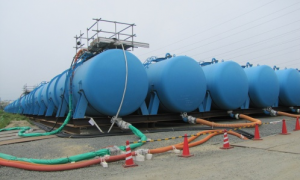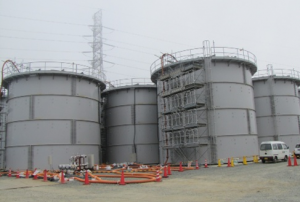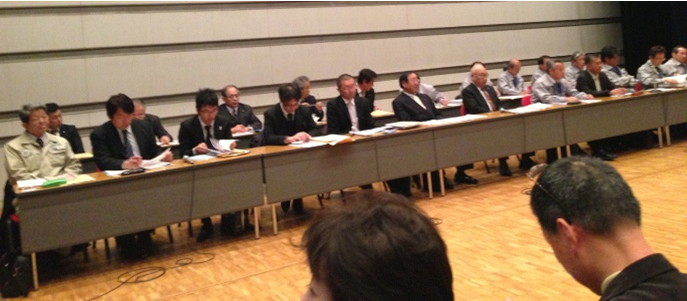Fukushima Daiichi Nuclear Power Plant and polluted water ? – a difficult challenge
To date, cleanup works have been going on, the long term aim being the removal of fuel debris and the cleanup of the plant.
Nevertheless, we face various kinds of obstacles that mankind has to deal with for the first time in the world history. Among these challenges, especially regarding the water issue, President Yamada explains as follows.
Increasing amounts of polluted water
In the units No. 1 to 3 in the Fukushima Daiichi, the reactors and containment vessels must be kept topped up with fresh water continuously, for the cooling of hot radioactive materials contained in fuel debris. This will go on until the completion of the fuel debris removal, projected to be done by 2022.
As those containment vessels are no longer water-tight due to the earthquake and successive explosions on and after March 11, cooling water is leaking from the containment vessels and stands up in the torus chamber consequently.
As water in contact with fuel debris is being contaminated with over 60 kinds of radioactive materials, including caesium, we have to prevent this polluted water from flowing into the groundwater.
For this reason, the water level in the torus chamber must be kept lower than the groundwater level, by pumping out. This means that the groundwater leaks backward into the contaminated water. It is reported that the influx amounts to 400 tons per day, equal to one and a half times the volume of a 25 meter long swimming pool (Japanese local standard), or 12,000 tons per month or 144,000 tons per year.
Presently, the polluted water is recycled, for cooling No. 1 to 3 reactors again after a phased process for oil separation, caesium removal (by zeolite), salt removal (by reverse osmosis membrane), and separation by distillation. The surplus is stored in separate tanks for, respectively, fresh water, highly concentrated water, condensed fluid wastes and condensed sea water.
Water storage in a temporary facility
Photo 1 below shows the condensed fluid waste tanks. The body seems sturdily built but the amount of random hose piping is eye-catching. The method of processing is not established yet, and the condensed fluid waste has to be reserved for over 10 years. Photo 2 shows tanks for fresh water (without salt and caesium). Although the water is fresh, it contains more than 60 kinds of radioactive materials besides caesium; accordingly, it cannot be sprayed on the ground or drained into the sea.
 Unlike the welded tanks in Photo 1, these tanks are assembled with nuts and bolts, and accidental leaks have happened from time to time. Recent plans call for the construction of a bank around the tank yard.
Unlike the welded tanks in Photo 1, these tanks are assembled with nuts and bolts, and accidental leaks have happened from time to time. Recent plans call for the construction of a bank around the tank yard.
 Furthermore, the construction of underground storage tanks is underway. The accumulated storage capacity was counted to be 3,200,000 tons as of January 29. There are projects for enlarging the total capacity by up to 700,000 tons by the middle of 2015, in order to cope with increased water volumes.
Furthermore, the construction of underground storage tanks is underway. The accumulated storage capacity was counted to be 3,200,000 tons as of January 29. There are projects for enlarging the total capacity by up to 700,000 tons by the middle of 2015, in order to cope with increased water volumes.
Advanced Liquid Processing System (ALPS)
The ALPS, a facility for removing more than 60 radioactive nuclides other than caesium, has been constructed since last year, and its experimental operation was authorized by Nuclear Regulatory Agency on Feb. 21.
This authorization however came with a special provision that the treated water containing tritium must not be discharged into the sea. The ALPS does not have a tritium removal capability.
The TEPCO’s initial plan was projected to reduce the accumulated water to zero at the beginning of 2020. That was to be achieved by continuously reducing water by 100 tons a day, on a basis of 400 tons a day of groundwater inflow minus 500 tons a day by draining and/or spraying after the ALPS treatment. But this initial plan for the polluted water storage and treatment is bound to fail, due to the prohibition against discharge into the sea.
Pumping Well and Water Shielding Wall
TEPCO plan to dig 12 pumping wells (6 have been completed) for groundwater on the mountainside of the reactors, to lower the groundwater level and thereby to reduce the groundwater inflow into the contaminated water.
At the same time, they are driving steel pipe piles reaching the bedrock at tens of meters deep in the seaside of existing quay to prevent polluted water from flowing into the port. (To be completed in fiscal year 2014)
Further, they plan to avoid leakage of the groundwater into the sea by means of pumping out the groundwater from pits between the existing quay and the water shielding wall, and keeping the groundwater level in the pits below the average tide level.
However, they have not presented any explanation about treating the radioactive materials possibly contained in the pumped groundwater.
Nor is there in the TEPCO document any explanation of how these measures influence the groundwater flow routes and cause a change on the inflow water.
It is not technically easy to simulate the behaviour of the groundwater with any accuracy.
This shows you that cleanup of Fukushima Daiichi is impossible only by nuclear technology.
The cleanup of Fukushima Daiichi involves such significant technological and managerial problems besides the nuclear technology. It is necessary to watch the progress carefully hereafter.
Monthly Report of the Watcher Team (Summary) March 2013
(A: Summary of TEPCO Home Page article B. Comments by Watcher Team)
1. Cooling of the spent fuel pools and the reactors
A. (TEPCO):
The temperature at all of the designated points placed at the facilities is stable and does not show significant irregularity.
B. (Watcher Team):
The temperature is stable at the moment, but it should be kept being watched because all of the facilities are makeshift.
2. Contaminated Water
(1) Balance of Inflow and Outflow of Water
A. (TEPCO):
The accumulated water would be zero at the beginning of 2020, if drain and spray rate of water decontaminated by the ALPS is 500 m3/day and the inflow rate of the underground water is 400 m3/day.
B. (Watcher Team):
There are many unknown factors such as how the ALPS works. The water shielding walls that are being installed at the quay may cause an increase in the volume of pumped-out water.
(2) Pumping Well
A. (TEPCO):
6 of 12 planned wells have been constructed. At present the water is not contaminated and it is possible to drain the water as is.
B. (Watcher Team):
The underground water level can be lowered, but that requires lowering the water levels in the reactor buildings. And how it influences a decrease of the underground water inflow is unknown.
(3) Water Shielding Wall
A. (TEPCO):
Walls assembled with steel pipes to prevent underground water from flowing into the sea are under construction, and they will be completed in fiscal year 2014.
B. (Watcher Team):
It is anticipated that polluted underground water blocked by the wall will have to be pumped up. The effect of the wall on water flow is unknown.
(4) Steel Tank
A. (TEPCO):
Even if water leakage from the tanks occurs, the volume of the leaked water would not exceed 1000 m3.
B. (Watcher Team):
It is not expected that a tank with nuts-and-bolt-jointed side walls has a lifetime longer than 10 years. In the future, further measures are inevitably needed.
3. Port and Marine Pollution
A. (TEPCO)
Replacement of the silt fences and coverage of the seabed soil are found effective. It is difficult to remove radioactive Sr from the seawater. The fish contaminated with radioactive materials are being caught both inside and outside of the port.
B. (Watcher Team):
The contaminated water may continue to flow into the sea until the completion of construction of the water shielding walls. It will be necessary to dredge the bottom of the port for ships loaded with machinery and materials to come in and go out, but this might expand the contaminated area.
4. Radioactive Waste
A. (TEPCO):
Due to radioactive materials on the premises, the environmental radioactivity at the boundaries of it is still high. The progress in reducing it is delayed.
B. (Watcher Team):
Permanent measures such as incineration disposal or airtight storage may be required.
Meeting Tours
In the new year of 2013, SVCF meetings were held in Niigata and Kanagawa Prefectures. In April a similar round is also planned in Nagoya.
Why don’t you plan one in your region? Showing a DVD copy of the documentary TV program titled “Message from Seniors ― The will of Skilled Veterans Corps”, produced by Fukushima Chuo TV Co. (ref. SVCF Bulletin 29), would be a good eye-catcher for such an assembly. The DVD is available for free borrowing at the SVCF head office.
In Niigata City
On January 28 SVCF resident members in Niigata turned out for a meeting in a rental Karaoke Box. Mr. Takayasu Sugiyama, who had participated in a SVCF official visit to the TEPCO Fukushima No. 2 Nuclear Power Plant on January 16, briefed on the observation, the above-mentioned DVD was projected, and future SVCF activities were discussed.
In Yokohama City
14 members of SVCF Kanagawa Group, both regular and supporting members together, turned out in the Yokohama Naka Ward Citizen
Center on February 11. Mr. Takayasu Sugiyama, a group member, briefed on the observation report of Fukushima No.2 Nuclear Power Plant and then the year 2013 activities plan was discussed.
In Nagoya City
On April 19 a Tokai Group (covering Aichi, Mie and Shizuoka prefectures) is to be assembled in Nagoya. Details will be given in the next SVCF Bulletin, dated April 1.
Observations from a meeting for local residents, organized by the “Tomioka Machi” town office

At the Japan Telecommunications Workers’ Union (Chiyoda Ward, Tokyo) Hall on February 13, the town office of Tomioka, Fukushima prefecture held a meeting to explain the current review for the Evacuation Admonition Area. Some SVCF members from Watcher Team of Administration & Legislation attended.
In an opening remark Mayor Katsuya Endo asserted that the evacuation admonition area status is to be reviewed at the end of March. The whole town of Tomioka is currently designated as “evacuation zone” and entry thereto is strictly limited. After the review at the end of March, the town would be subdivided into three, “Area where preparations for the abolishment of evacuation order are carried out”, “Restricted residence area” and “Area adverse to homecoming”.
However, the handouts distributed in the hall described that the review of this time would not mean the abolishment of the evacuation order for town residents, and the town officials also explained that the review of the area designation would not directly mean homecoming (resettlement).
The time of homecoming would be decided in some years later, they said. During Q&A session after a break, town residents brought forward a variety of opinions, demands and questions.
A female resident aged 54 harshly questioned the town mayor on how many old persons might go home after 5 years when radiation came down to safe level, and asked the mayor if he, at his age, thinks he could return home himself.
The mayor confidently commented that he would return home in 5 years and that he hoped to restore the town fully by all means available. For that purpose he was also fighting against the State.
A visit report on the TEPCO Fukushima No. 2 Nuclear Power Plant is posted in the website
The final edition of the report on the visit to the TEPCO Fukushima No. 2 Nuclear Power Plant on January 16 was published in the SVCF website on February 22.
The original report was handed to the TEPCO representative at the TEPCO head office on February 8.? Then the details of factual accuracy have been verified and adjusted with the TEPCO side for the final edition to be published on the website this time.
The report is consisted of two parts with the first “observation record” and the second “SVCF members’ opinions” chapters.
“Alumni association” in Tokyo University
Some graduates of 1962 from the Instrumentation Engineering, Department of Applied Physics, Faculty of Engineering, University of Tokyo, have promised to make a regular donation voluntarily to SVCF.
On February 13, 15 members of this voluntary group gathered in a class reunion, and heard a SVCF activities report from the SVCF vice president Shiotani.
Participants watched a DVD produced by Fukushima Central Television, and then exchanged views and opinions for an hour and a half.
Among many comments, for instance, “It was a pity that SVCF was unable to participate directly in the cleanup work just after the occurrence of accident.” or “Radiation measurements should be performed in all of Kawauchimura, so that SVCF can advise the village office of a decontamination plan.” was presented.
Announcement of the next regular Diet meeting
Please actively participate in the 23rd meeting in the house of the Diet to be held as follows.
Time and Date: March 21 at 14:00 p.m..
